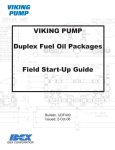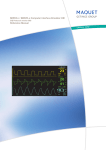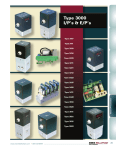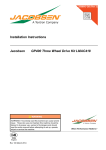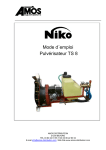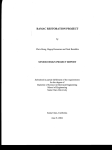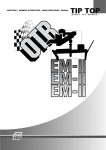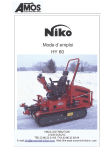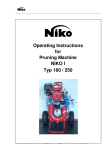Download Operating Instructions for HY 20-11
Transcript
Operating Instructions for HY 20-11 NIKO GmbH Maschinen- & Fahrzeugbau . Im Mühlgut 1 . D-77815 Bühl-Weitenung Preface Dear customer, We would like to thank you for your confidence in purchasing a NIKO-product. We have done our best to provide you with a performance oriented and dependable product. We ask you to please read the operating instructions carefully before starting up the machine, and to observe all the instructions. The operating instructions will give you detailed information about operation and valuable information about startup, maintenance, and service. As you know, the warranty does not cover any claims resulting from operating error or inappropriate use. When ordering spare parts, accessories, or when submitting complaints, please include the following data: Type: HY 20-11 Machine No: Year of Build: Technical Improvements: We are always trying to improve our NIKO-products. We therefore reserve the right to implement all improvements and changes we deem necessary to our products, without further announcement, and without obligation of updating machines already sold. We are glad to answer any further questions you may have and wish you lots of fun with your new NIKOproduct. Best regards, N I K O Maschinen- & Fahrzeugbau Serr Dieter, General Manager NIKO GmbH Maschinen- & Fahrzeugbau . Im Mühlgut 1 . D-77815 Bühl-Weitenung Table of Contents • Product Description 1.) Appropriate Use 2.) Assembly 3.) Functional Description 4.) Technical Data Spare Parts Lists 5.) EC-Conformity Declaration • General Safety Information 1.) Operator Care 2.) Description of Safety Symbols • Transport 1.) Dimensions and Weight 2.) Dependable Transport Devices and Aids 3.) Transport to the Operating Site • Startup • Operation 1.) Operator Working Area 2.) Operation • Maintenance 1.) Cleaning and Lubrication 2.) Service • Help with Breakdowns • Machine Data NIKO GmbH Maschinen- & Fahrzeugbau . Im Mühlgut 1 . D-77815 Bühl-Weitenung Product Description This special machine was built for use on inclines, in swampy areas, and uneven and difficult to reach areas. The application starts where others have already stopped: At an inclination of 30 % – 65 %, depending on the ground conditions! It’s low weight, minimal ground pressure ( easy on the ground surface ), the ease in handling and work safety are baffling. All accessory units are hydraulic driven. 1. Appropriate Use The hydrostatic Mini-Caterpillar HY 20-11 is exclusively intended for the following use: - For driving on uneven ground and on steep inclines. The machine is not intended for any other purpose than described above – any other use is considered inappropriate use. We especially note here that it is prohibited to - drive on macadamized surfaces for extended periods of time drive in street traffic install foreign accessory units. Only NIKO-accessory units may be used. Observe all technical data. 2. Assembly Sicherheitsbügel Haltebügel Steuerhebel Schnellspanner Safety bar Holding bar Control lever Fast tensioner Benzin/Diesel-Tank Knieschoner Haltegriff Verstellbarer Fußtritt Fuel/diesel tank Knee protector Holding grip Adjustable foot step 1 Sicherheitsbügel Haltebügel Steuerhebel Haltegriff Benzin/ Diesel-Tank Knieschner Schnellspanner Verstellbarer Fußtritt 2 Oil fill pipe with Oilstick Tensioning leverfor accessory units Oiltank Gear-pump and axial-flow pumps Fast Tensioner 3-Point Oil-engine with brake Hydraulic cylinder for unit lifting 3 Hydrauliksteuerventil für Verstellb. Fußtritt Hydrauliksteuerventile für Geräteaushebung Sicherheitsbügel (Totmannschaltung) Steuerhebel Gashebel Haltebügel Luftfilter 3-Wege-Hahn Ölkühler Knieschoner Benzinmotor Zündschloss Handstarteinrichtung Unterbrechungsknopf Ölfilter Fußtritt 4 3. Functional Description Startup Procedure Pull the choke lever on the engine when the engine is cold, in driving direction to the left and turn the ignition key clockwise. As soon as the engine starts up, the choke can first be reduced, then released completely. Once the engine is warmed up it is not necessary to pull the choke, but the interrupt button has to be activated. Driving the Caterpillar After the engine has started up, first slightly pull in the safety bar so that it is located between both dead man buttons, then the control lever can be operated. • • • • • • Pull lever B in far enough to free up both switches (approx. halfway). Move lever A in driving direction and adjust the driving speed. Pull lever B up to the stop (cruise control). Now only the left/right direction can be adjusted with lever A. To newly adjust driving direction and speed, bring lever B to center position. When lever B is brought to home position, the machine brakes immediately (dead man switch). (Only use lever C when operating with accessory units) When the safety bar is released the brake engages immediately (dead man switch), and the caterpillar stops immediately. The engine's speed (rpm) can be adjusted with the gas lever. By pressing the control lever forward or backward the caterpillar moves into the respective direction. The speed can be varied by moving the control lever. It can be fixed by pulling the safety and holding levers (cruise control). Turning the control lever to the left or right changes the driving direction accordingly. This is also possible when the cruise control is active. Hydraulic Control Valves Hydraulic Control Valve for Adjustment of the Foot Step (on Right, in Driving Direction) By pressing the control valve lever in driving direction, the foot rest and the holding bar lift upward and to the front, so that it is possible to stand horizontally above the machine when driving uphill. For downhill driving the foot step has to be moved to the initial position by pulling the control valve lever back. Hydraulic Control Valve for Hydraulic Unit Lifting (Moving) By pulling the control valve lever against driving direction the accessory units can be lifted up, by pulling the lever into driving direction they can be lowered. When fertilizer spreader or turbo-sprayer with movable frames are attached, the units are shifted to the front or the rear. 3-Way Shut-Off valve with Hydraulic Connections For oil supply of hydraulically driven accessory units, such as leave cutter, fertilizer spreader, stacker, and rod brush. Only activate shut-off valve when accessory units are used ( lever C, see diagram on previous page). For this, please observe the General Safety Guidelines. 5 4. Technical Data Dimensions Length: Width: Height: Weight: • • • • • • • • • • • • • • • • • 1.66 meters 0.90 meters 1.30 meters 400 kg Robust frame ( carrying capacity up to 1200 kg ) Hydraulically adjustable foot step Hydrostatic drive via dual pump, 11 cbm 2 oil engines, 7 hp each Oil-cell multiple-disk brake Dual control valve or triple control valve at additional charge Specialty oil filter with injector Electro-magnetic brake Rubber chains 230 x 38 x 72 cm, or alternately 190 x 38 x 72 cm Special 3-point holder 4-cycle-fuel engine, 20 hp Dead man switch Operating hour counter Odometer Double-acting stroke cylinder Oil cooler Continuous speed 0 – 8 km/h, forward and backward 6 7 Art. No. Pos. No. Description 50101 Pos. 1 Base frame 50102 Pos. 2 Rubber chain 38x72x200 / 38x72x230 50103 Pos. 3 Chain tensioner M20x200 50104 Pos. 4 Tensioning nut M20 50105 Pos. 5 Spring washer, 16 pcs. Ø25x50x3 50106 Pos. 6 Distributor 50107 Pos. 7 Guide wheel Ø200 50108 Pos. 8 Ball bearing no. 6006 2 RS 50109 Pos. 9 Locking ring DIN 472 50110 Pos. 10 Washer Ø13x37 DIN 9021 50111 Pos. 11 Hex head scew M12x20 DIN 933 50112 Pos. 12 Ball bearing no. 6204 2 RS 50113 Pos. 13 Drive wheel 50114 Pos. 14 Spacer pipe Ø21x25x52 50115 Pos. 15 Washer Ø10.5x30 DIN 9021 50116 Pos. 16 Hex head screw M10x16 DIN 933 50117 Pos. 17 Frame top 50118 Pos. 18 Hex head screw M8x25 DIN 933 50119 Pos. 19 Washer Ø9x50x6 50120 Pos. 20 Chain wheel Z10 50121 Pos. 21 Hex head screw M12x50 DIN 931 50122 Pos. 22 Clamping axle Ø35 50123 Pos. 23 Battery, 12 volt, 20 amp / Varta 52012 50124 Pos. 24 Locking ring A12 DIN 471 50125 Pos. 25 Cu-washer Ø12x16x1 DIN 7603 50126 Pos. 26 Control plate 50127 Pos. 27 Control bolt 50128 Pos. 28 Socket, brass Ø12x16x16 50129 Pos. 29 Safety pin 50130 Pos. 30 Hex head screw M8x20 DIN 933 50131 Pos. 31 Nut M4 DIN 985 50132 Pos. 32 Allen head screw M4x16 DIN 912 50133 Pos. 33 Tensioning lever 50134 Pos. 34 Pressure spring 50135 Pos. 35 Tensioning bolt 50136 Pos. 36 Cylinder 50137 Pos. 37 Bolt 50138 Pos. 38 Hex screw M10x20 DIN 933 50139 Pos. 39 U-traverse 50140 Pos. 40 Solenoid 8 9 Pos.No. Art. No. Description Pos. 1 50301 Lower frame / foot step Pos.No. Art. No. Description Pos. 30 50330 Nut M8 DIN 934 Pos. 2 50302 Upper frame Pos. 31 50331 Gas lever Pos. 3 50303 Step Pos. 32 50332 Control valve Pos. 4 50304 Washer M8 DIN 125 Pos. 33 50333 Control joint right M8 Pos. 5 50305 Nut M8 DIN 934 Pos. 34 50334 Nut Pos. 6 50306 Hex head screw M10x50 DIN 33 Pos. 35 50335 Control rods, length 335mm Pos. 7 Pos. 36 50336 Nut left M8 Pos. 8 50307 Hex head screw M10x75 DIN 933 50308 Washer M10 DIN 125 Pos. 37 50337 Control joint left M8 Pos. 9 50309 Nut M10 DIN 934 Pos. 38 50338 Nut M8 DIN 934 Pos. 10 50310 Pressure spring Pos. 39 50339 Allen head screw M4x6 DIN 912 Pos. 11 50311 Washer Ø12.5 Pos. 40 50340 Solenoid Pos. 12 50312 Pin Ø3.5x30 Pos. 41 50341 Solenoid plate Pos. 13 50313 Safety bar Pos. 42 50342 Solenoid, mounting plate Pos. 14 50314 Allen head screw M5x10 DIN 12 Pos. 43 50343 Pin Ø5x25 Pos. 15 50315 Aluminum cover plate Pos. 44 50344 Aluminum flange with bearing Pos. 16 50316 Hex head screw M8x55 Pos. 45 50345 Hex head screw M6x16 DIN 933 Pos. 17 50317 Cover housing Pos. 46 50346 Control lever Pos. 18 50318 Control button Pos. 47 Pos. 19 50319 Holding bar, pivotable Pos. 48 50347 Hex head screw M12x50 DIN 933 50348 Washer M12 DIN 125 Pos. 20 50320 Washer M8 DIN 9021 Pos. 49 50349 Nut M12 DIN 985 Pos. 21 50321 Hex head screw M8x50 DIN 933 Pos. 50 50350 Stroke cylinder Pos. 22 Pos. 51 50351 Oil cooler Pos. 52 50352 Hex head screw M6x20 DIN 933 Pos. 24 50322 Hex head screw M10x50 DIN 933 50323 Hex head screw M12x35 DIN 933 50324 Washer M12 DIN 125 Pos. 53 50353 Washer M6 DIN 9021 Pos. 25 50325 Knee protector Pos. 54 50354 Nut M6 DIN 985 Pos. 26 50326 Washer M10 DIN 125 Pos. 55 50355 Hex head screw M6x65 DIN 933 Pos. 27 50327 Hex head screw M10x50 DIN 33 Pos. 56 50356 Spacer Pos. 28 50328 Hex head screw Pos. 57 50357 Fuel tank Pos. 29 50329 Mounting plate Pos. 58 50358 Odometer Pos. 23 10 11 Art. No. Pos. No. Description Art. No. Pos. No. Description 50201 Pos. 1 V-motor, 2-cylinder 50243 Pos. 43 Leakage oil line 50202 Pos. 2 Aluminum flange 50244 Pos. 44 Leakage oil line 50203 Pos. 3 Washer Ø10.5 50245 Pos. 45 Hydro brake 50204 Pos. 4 Allen head screw M10x30 DIN 912 50245a Pos. 45a Brake switch valve 50205 Pos. 5 Fitted key 50245b Pos. 45b Hydraulic motor 50206 Pos. 6 Motor clutch, Ø 25 inside 50246 Pos. 46 Double nipple 50207 Pos. 7 Washer Ø10.5 50247 Pos. 47 Brake hose wheel 50208 Pos. 8 Hex head screw M8x25 DIN 933 50248 Pos. 48 Brake hose 50209 Pos. 9 Rubber damper 50248a Pos. 48a T-piece 50210 Pos. 10 Allen head screw M5 50249 Pos. 49 Brake hose 50211 Pos. 11 Washer Ø5.5 50250 Pos. 50 Banjo bolt 50212 Pos. 12 Washer Ø10.5 50251 Pos. 51 Brake hose 50213 Pos. 13 Nut M10 50252 Pos. 52 Brake line 50214 Pos. 14 Axial-flow pump APVC-11+11200 Pb4RS1 50253 Pos. 53 Washer Ø8.5 50215 Pos. 15 Connection pipe 50254 Pos. 54 Hex head screw M8x16 DIN 933 50216 Pos. 16 Connection hose 50255 Pos. 55 Oil tank 50217 Pos. 17 Hose nipple DN10 - 3/8" 50256 Pos. 56 O-ring 50218 Pos. 18 Hollow screw 50257 Pos. 57 Oil fill plug Ø1" with oil stick 50219 Pos. 19 Fitting connection RSWV 15l 50258 Pos. 58 Hose nipple DN 16 - ¾" 50220 Pos. 20 Banjo bolt ½" 50259 Pos. 59 Hose clamp Ø16-25 50221 Pos. 21 Pressure hose DN 12 2 S/N motor 50260 Pos. 60 Suction hose DN 16 50222 Pos. 22 Pressure line 50260a Pos. 60a Return hose 50223 Pos. 23 Double nipple 50261 Pos. 61 Stud M10x30 50224 Pos. 24 Fitting connection GES 15l ½" double nipple 50262 Pos. 62 Washer Ø8.5 50225 Pos. 25 Pressure line Pos. 63 Hex head screw M8x16 DIN 933 50226 Pos. 26 Slewing joint 50264 Pos. 64 Washer Ø10.5 50227 Pos. 27 Volume separator 50265 Pos. 65 Nut right 50228 Pos. 28 Suction connection DN 16 - ½" 50266 Pos. 66 Control linkage 50229 Pos. 29 Pressure hose motor 50267 Pos. 67 Nut M8 left 50229a Pos. 29a Pressure hose motor 50268 Pos. 68 Control linkage 50230 Pos. 30 50269 Pos. 69 Joint M8 50230a Pos. 30a Double nipple 50270 Pos. 70 Hex head screw M8x20 DIN 933 50231 Pos. 31 Banjo bolt 3/8" 50271 Pos. 71 Extension plate 50232 Pos. 32 Fitting connection RSWV 12l-3/8" 50272 Pos. 72 Safety ring Ø30 outside 50233 Pos. 33 Suction hose DN 10 50273 Pos. 73 Washer Ø30x38x2.5 50234 Pos. 34 Leakage oil line 50274 Pos. 74 Torsion spring Ø3 50235 Pos. 35 Pipe clamp 50275 Pos. 75 Washer Ø8.5 50236 Pos. 36 Leakage oil line 50276 Pos. 76 Nut M8 50237 Pos. 37 Manifold hydraulic oil 50277 Pos. 77 Clutch pump side 50238 Pos. 38 Hose clamp 50278 Pos. 78 Pressure line 50239 Pos. 39 Leakage oil line 50279 Pos. 79 3-way shut-off 50240 Pos. 40 Leakage oil line 50280 Pos. 80 Pressure line 50241 Pos. 41 Leakage oil line 50281 Pos. 81 Return 50242 Pos. 42 Magnetic switch Double nipple 50263 12 EC-Conformity Declaration According to II A of EG-Machine Guidelines (89/392/EWG) The manufacturer: Hereby declares, that the machine described as follows: NIKO GmbH Maschinen- & Fahrzeugbau Im Mühlgut 1 D-77815 Bühl-Weitenung Germany NIKO-Climber Type HY 20-11 Machine No. Complies with the safety and health requirements EC-Machine Guidelines 89/392/EEC of the following EC-Guidelines: Version 93/44/EEC Harmonized standards applied: DIN EN 292 Safety of machines: Part 1 Basic definitions, general design guidelines Part 2 DIN EN 294 DIN EN 349 Technical guidelines and specifications Safety distances to avoid contact of upper body parts with dangerous area Minimum distances to avoid pinching of body parts Machine safety; emergency-stop device DIN EN 418 DIN EN 60204 Machine safety; general requirements for electrical machine equipment Part 1 : This conformity declaration is voided by constructive changes, affecting both technical data stated in the operating instructions and appropriate use, altering the machine significantly! Bühl, Date Serr Dieter, General Manager 13 General Safety Information 1. Operator Care The Caterpillar Hydro 20-11 was constructed and manufactured according to an endangerment analysis and after careful selection of the harmonized norms to be observed, as well as further technical specifications. It fulfills state-of-the-art requirements and ensures a maximum of safety. However, these safety standards can only be maintained in practical use when all necessary measures are taken. It is the responsibility of the machine operator to plan these measures and monitor their execution. The operator especially has to make certain, that - - the machine is only used for the intended purpose (see chapter ‘‘Product Description‘‘). the machine is only operated in faultless and functional condition, and especially, that the functionality of the safety devices is regularly checked. personal safety equipment for operating personnel, maintenance personnel, and repair personnel is available and being used. the operating instructions are complete and in readable condition, readily available at the machine operating site. the machine is only operated, maintained and repaired by qualified and authorized personnel and that the personnel is instructed regularly as to applicable questions of work safety and environmental protection and has knowledge of the operationg instructions and, especially, the safety information. all safety and warning labels remain on the machine, and are in readable condition. aside from the information in the operating instructions, the generally applicable safety and accident protection guidelines are observed. applicable regulations are observed when using official roadways. before starting work, you know about all devices and control elements, as well as their functions. When work is already in progress it will be too late for this! the engine is started only from the driver seat. The engine may not be started by hot-wiring the electrical connections on the starter, since the machine may start moving immediately. the clothing of the driver fit tightly. Avoid baggy clothing. - Check the immediate area before starting to drive (!!!CHILDREN!!!). Make sure you can see sufficiently! - Do not start the engine in closed rooms. (DANGER OF SUFFOCATION)! - Take care when handling gasoline – increased danger of fire!!! Never refill gasoline near open flames or sparks. DO NOT SMOKE while refilling gasoline!!! - 1 GENERAL SAFETY INFORMATION 1. - Operator Care Before refueling shut down the engine and pull the ignition key. Do not refuel in closed rooms. Wipe away spilled gasoline immediately (danger of ignition). To avoid danger of fire, keep machine in clean condition! Be careful when handling battery acid (POISONOUS & CORROSIVE) ! Check the caterpillar for traffic and operating safety before each startup ! The vehicle may only be operated by persons who are in good physical and mental condition. It is not allowed to take medication or drink alcohol before operating the vehicle. The vehicle may not be operated by minors. It is prohibited to transport passengers! The driving speed must be adapted to the conditions of the terrain. When driving on curvy terrain with attached or mounted attachments, the additional length and the flywheel mass have to be considered! Secure the caterpillar against rolling, shut down the engine. (By shutting down the engine the hydraulic brake engages). Pull the ignition key. Never leave caterpillar unattended as long as the engine is running. Don’t ever leave the driver seat during operation. Lower attachments completely before leaving the caterpillar! Hydraulic fluid leaking at high pressure (gasoline, hydraulic oil) can penetrate the skin and cause serious injuries. So please consult a physician immediately, otherwise serious infections may result. The mounting of the chain requires sufficient knowledge and safety precautions. Check screws and connecting elements for tightness and retighten, if necessary. The chain needs to be retightened initially after approx. 10 hours, after that when needed. When working on electric equipment always remove the ground from the battery. Mount attachments only with the recommended devices. Only operate the caterpillar when all safety devices are attached and in proper position. The driving speed always has to be adapted to the terrain. 2. Explanation of Safety Symbols The following safety symbols are used in these Operating Instructions. The symbols are intended to specifically make the reader aware of adjacent safety information. These symbols should make you aware that there is danger to life and personal health. Caustic Materials Fire Hazard Corrosive Materials Poisonous Smoking Prohibited Fire Hazzard 8 Ätzende Stoffe Caution Children Danger of Suffocation 2 Transport To avoid machine damage or life threatening injuries during setup of the machine, the following points absolutely have to be observed: - Transport of the machine may only be handled by qualified persons in observance of the safety information. The machine may only be lifted using the holding points provided. For transport of the machine only carrying devices and hardware described here may be used. Also read the chapter on ‘‘General Safety Information‘‘. 1. Dimensions and Weight • • • Total length Total width Total height 1.66 meters 0.90 meters 1.30 meters 2. Dependable Transport Devices and Aids The caterpillar can be transported on a pallet with a fork lift. 3. Transport to the Operating Site The caterpillar gets transported to your site on a truck or trailer. Startup To avoid machine damage or life threatening injuries during startup of the machine, the following points absolutely have to be observed: - Assembly and installation of the machine may only be done by qualified persons in observance of the safety information. Before first startup, check that all tools and foreign parts are removed from the machine. Test all safety devices and the emergency-stop switching them on and off before starting with operation. (Before startup, check the running direction of the motor) Also read the chapter ‘‘General Safety Information‘‘. 1 Operation To avoid machine damage or life threatening injuries during operation of the machine, the following points absolutely have to be observed: - The machine may only be used/operated for the purpose it is intended for. - Before startup of the machine, inform yourself about appropriate action in case of breakdown. - Before startup of the machine, check the functions of the following units: - Protective covers and - emergency-stop switch - Also read chapter "General Safety Information". 1. Operator Working Area The exclusive work place of the driver is the driver seat. 2. Operation Basic Rule: • Check the caterpillar for traffic and operating safety before every startup. Transport of persons, passengers, operators: • Nobody except the driver himself may be transported Driving Operation: • • • The driving speed has to be adapted to the environmental conditions and attachments mounted. When driving on curvy roads with connected or mounted attachment, the additional length and the flymass of the attachments have to be observed. Never leave the driver seat while the vehicle is in operation – danger of accident! Leaving the Caterpillar • • • • • • Secure the caterpillar against unintended movement when leaving. Shut down the engine. Pull the ignition key. Never leave the caterpillar unattended while the engine is running. Never leave the driver seat during operation. Lower the attachments completely before leaving the caterpillar. Attachment Units • 1. • • • • • • Attachments may only be fastened with the recommended fastening devices. Only operate the caterpillar when all safety guards are attached and in proper position. Only NIKO-attachment units may be used. NIKO is not liable for the use of any other attachment. There is danger of injury when mounting attachments to the caterpillar. There is danger of being pinched and/or cut in the area of the 3-point system. Do not step between the caterpillar and the attachment during remote operation of the 3-point system. It is not allowed to stand between caterpillar and attachment if the vehicle is not secured against rolling with the locking brake and/or blocks. When driving curvy roads with connected or mounted attachments also observe the extra length and the flymass of the attachment. 1 Maintenance and Service To avoid machine damage or life threatening injuries during maintenance of the machine, the following points have to be observed under all circumstances: - All working steps for maintenance of the machine absolutely have to be conducted in the order listed. First secure the immediate area for maintenance of the machine. Shut down all power supplies and secure them against unintended restart. Shut down all compressed air units. Only use the operating fuels recommended. Only use spare parts specifically listed in our spare parts lists. Also read chapter „General Safety Information“. 1. Cleaning and Lubricating Clean and lubricate all clutches, plugs, and movable parts after every operation. 2. Service • • • • • • • • • • • • Check chain tension initially after approx. 10 hours, afterwards at least every 50 hours and adjust, if necessary. Retighten lug nuts after 50 operating hours. Change motor oil after approx. 50 hours. Change hydraulic oil and filter after approx. 150 hours. Check or change fuel filter and spark plugs. Check valve adjustment ( intake 0.10 mm, outlet 0.15mm) Clean and oil carburetor and steering linkage. Clean motor oil cooler by freeing it thoroughly from dirt and grass. Check chain tension and adjust, if necessary. Check hydraulic connections and hoses for tightness. Observe the maintenance plan provided by the manufacturer. Periodically clean motor oil cooler and steering linkage by freeing them thoroughly from dirt and grass. Briggs & Stratton Oil filter Air filter Air filter, rubber Spark plugs No. 492932 No. 394018S No. 272490S No. 491055 Hydraulic filter Oil combination No. E.084-78 No. 10W-30MC Engine Maintenance • • • • • • • • • • • Do not perform any maintenance work while the engine is running. When working on the engine always disconnect the battery (minus position). Secure the standing caterpillar on inclines using blocks. Pull the ignition key. Only refill fuel when the engine is shut off. Observe the recommended quality of oil and fuel, and store them only in approved containers. Caution when draining hot oil – danger of scalding! Dispose of used oil in a responsible manner. Oil and cooling agent are under pressure – danger of scalding! Reinstall safety devices after service. Do not use starter liquid when using electric starter. 2 • • The starter liquid is flammable and explosive. Empty used and apparently empty pressurized spray cans completely in an open area, free of sparks and flames. Electrical Equipment • • • • • • • When working on the electrical equipment always disconnect the battery (minus position). Make sure to reconnect in the correct order – first the plus position, then the minus position. Caution with battery gases – they are highly explosive. Avoid sparking and open flames, as well as smoking near the battery. Only use original fuses. Too strong fuses can destroy the electrical equipment. Activate the starter only for a short time, otherwise the coil will overheat. Let the starter cool down. Do not weld, drill, saw, or grind on the caterpillar or the safety frame. If damage has occurred, have the parts replaced. Attachment Units • • • • • • • Before attaching units, bring the 3-point system lever into proper position to avoid unintended raising and lowering. There is danger of injury when mounting attachments to the caterpillar. There is danger of pinching and cutting in the area of the 3-point system. Do not step between the caterpillar and the attachment during remote operation of the 3-point system. It is not allowed to stand between caterpillar and attachment if the vehicle is not secured against rolling with the locking brake and/or blocks. When driving curvy roads with connected or mounted attachments, also observe the extra length and the flymass of the attachment. Attachments may only be fastened with the recommended fastening devices. Only operate the caterpillar when all safety guards are attached and in proper position. 3 Tensioning Device for Chain Tensioner 4 Help with Breakdowns To avoid machine damage or life threatening injuries when handling breakdowns of the machine, the following points must be observed: - Only attend to a breakdown if you are qualified to do so. - First secure the machine against unintended restart by ... - Ensure that the machine can be brought to a safe state by a second person at any time. - Secure the operating range of moving machine parts. - Also read chapter „General Safety Information“. Cause Remedy Motor does not start Check battery, check fuel/diesel, clean or change air filter Check hydraulic oil, check hoses, check control lever, release brake, check brake mechanism, press interrupt button, read the motor manual Caterpillar does not move 5 Warranty NIKO-products are built using modern manufacturing technologies with a maximum of care, subjected to numerous quality controls. This is why NIKO offers a 12 months warranty, if the following conditions are met: 1.) The warranty starts at date of purchase. 2.) The warranty includes material and manufacturing defects. For subsupplier parts (hydraulics, electronics, engine) we are only responsible to the extend of the warranty of the respective subsupplier. During the warranty period fabrication and material defects are handled free of charge by replacement or refitting of parts in question. Others, further claims, such as trade, discount, or damage compensation not concerning the delivered products are explicitly excluded. Warranty claims are exclusively handled by authorized repair shops, NIKO-manufacturing representatives, or the manufacturer. 3.) Excluded from the warranty are damages due to wear, soiling, corrosion, and all faults caused by inappropriate use and its consequences. Also, unauthorized repairs or changes of original conditions void the warranty. No recovery of damages is possible if spare parts other than original NIKO-parts are used. Therefore, please pay special attention to the operating instructions. Direct any questions you may have to our manufacturing representatives or directly to the manufacturer. Warranty claims have to be submitted to the manufacturer within 30 days form the date of damage. Please provide the date of purchase and the machine number and use the warranty form provided. Warranty repairs can only be carried out by an authorized repair shop, after consulting with NIKO. Please advise your repair shop accordingly. Repairs done under warranty do not extend the warranty period! Faulty transport is not a manufacturing fault, and therefore, is not the responsibility of the manufacturer. 4.) Claims for damages other than on the products itself are excluded. This includes liability for damages resulting from operating error. Unauthorized modifications to the product can lead to damages and release the shipper from any responsibility for these damages. 6




























